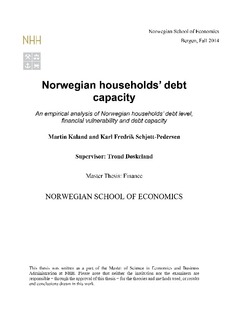Norwegian households’ debt capacity : an empirical analysis of Norwegian households’ debt level, financial vulnerability and debt capacity
Master thesis
Permanent lenke
http://hdl.handle.net/11250/2639253Utgivelsesdato
2014Metadata
Vis full innførselSamlinger
- Master Thesis [4372]
Sammendrag
We have conducted a descriptive and empirical analysis of the Norwegian household debt based on micro data for all Norwegian households. We identify the drivers behind the significant growth in debt levels over the last decade. We further assess the households' financial stability and vulnerability using financial ratios capturing their financial buffers and debt servicing ability. Our work builds on previous studies of the Norwegian households’ debt, but include a more thorough analysis of their financial vulnerability as our stress tests decompose the households in segments by age, income and geographic region. We further identify the households’ debt capacity, i.e. how much debt they can acquire before they are categorised as financially vulnerable.
Despite the significant growth in debt levels, we find low levels of financially vulnerable households, suggesting that Norwegian households can support even higher debt levels. In 2012, 2.2% of the total debt was identified as vulnerable with high likelihood of default. The stress tests did however reveal that the high debt levels make the households sensitive for increased interest rates in particular. Hence, suggesting that the government and the supervisory authorities should continue to monitor the households closely.
There is considerable debt capacity within the household sector according to our estimates. We find the households to have potential of doubling their debt from the 2012 levels before they are categorised as financially vulnerable. We do however find the households likely having the highest demand for debt to have the least free debt capacity, suggesting that we are unlikely to see full capacity utilization. This enhances the view that the Norwegian credit market for households are approaching a more mature stage with lower credit growth compared to the last ten years.
